Greater galangal
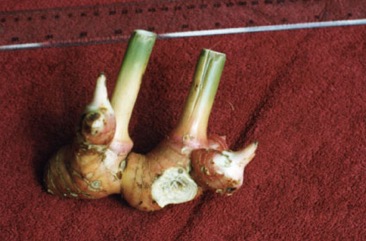
A tropical plant. It does best in rich moist soils. It prefers a protected shady position. It is drought and frost tender. The soil needs to be well-drained. It can be grown in sheltered sites in cooler climates but needs a heated glasshouse in cold places. In China it grows in grasslands between 100-1300 m altitude in S China. It suits hardiness zones 9-12. In XTBG Yunnan.
Also known as:
Ampar, Ampar haldi, Araththa, Dumbarasme, Gao liang kiang, Gieng, Ha, Hong dou kou, Jiang miao, Kanghoo, Kanghu, Kha, Kha baan, Khoa, Kol-inji, Kulanjan, Kulanjain, Kulinjan, Kunsa-gamon, Ladja, Lam kieu, Langkuas galangal, Laos, Lengkuas, Mi pi duo pu, Pa-de-gaw-gyi, Pedda-dumparashtram, Pera-rattai, Peraratta, Phrikan-gnek, Rieng, Romdeng, Siamese ginger, Tara, Tharai
Synonyms
- Alpinia alba (Retz.) Roscoe
- Alpinia bifida Warb.
- Alpinia carnea Griff.
- Alpinia galanga var. pyramidata (Blume) K. Schum.
- Alpinia pyramidata Blume
- Alpinia rheedei Wight
- Alpinia viridiflora Griff.
- Amomum galanga (L.) Lour.
- Amomum medium Lour.
- Galanga officinalis Salisb.
- Hellenia alba (Retz.) Willd.
- Heritiera alba Retz.
- Languas galanga (L.) Stuntz
- Languas pyramidata (Blume) Merr.
- Languas vulgare J. Koenig
- Maranta galanga L.
- Zingiber galanga (L.) Stokes
- Zingiber medium Stokes
- Zingiber sylvestre Gaertn.
Edible Portion
- Rhizome, Roots, Leaves, Seeds, Herb, Spice, Flowers, Vegetable
Where does Greater galangal grow?
Found in: Asia, Australia, Bangladesh, Cambodia, China, East Timor, Fiji, Guianas, Hawaii, India, Indochina, Indonesia, Laos, Malaysia, Myanmar, Northeastern India, Pacific, Philippines, SE Asia, Singapore, Sri Lanka, Suriname, Taiwan, Thailand, Timor-Leste, United States, Vietnam
Notes: There are about 200-230 Alpinia species. They are mostly tropical and subtropical. It is antimutagenic. It possibly has anti-cancer properties.
Status: It is a cultivated food plant. They are sold in markets. It is a commercially cultivated vegetable. The fruit are available in Chinese stores in Australia.
Growing Greater galangal
Cultivation: It is grown by dividing the rootstock. A piece about 5-10 cm long with at least 2 undamaged buds is used. Rhizomes are planted just below the surface and 60 cm apart.
Edible Uses: The root is used for flavouring curries. They are often sliced then removed before serving the dish. They can be pounded to a paste then added to dishes. They are also pickled. The young shoots and leaves are also eaten. Flower buds and flowers can also be cooked and eaten. They are also pickled. The red fruit are edible.
Production: Young rhizomes have more flavour than older ones.
Nutrition Info
per 100g edible portion| Edible Part | Energy (kcal) | Protein (g) | Iron (mg) | Vitamin A (ug) | Vitamin c (mg) | Zinc (mg) | % Water |
|---|---|---|---|---|---|---|---|
| Leaves | - | 0.5-1 | - | - | - | - | |
| Rhizome | 51 | 1 | 2.1 | - | - | 0.7 | 85.9 |
| Seed | - | - | - | - | - | - | |
| Flowers | - | - | - | - | - | - | |
| Fruit | - | - | - | - | - | - |
Greater galangal Photos

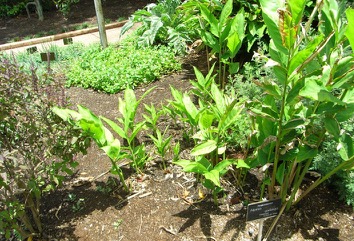
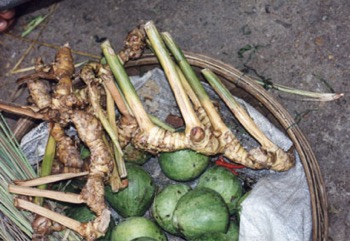
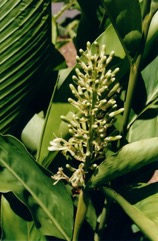
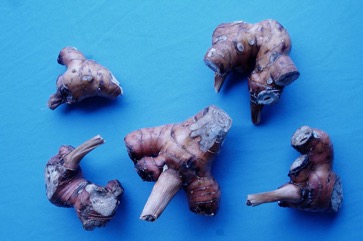
References
Ambasta S.P. (Ed.), 2000, The Useful Plants of India. CSIR India. p 30
Anderson, E. F., 1993, Plants and people of the Golden Triangle. Dioscorides Press. p 202
Arora, R. K., 2014, Diversity in Underutilized Plant Species - An Asia-Pacific Perspective. Bioversity International. p 99
Bircher, A. G. & Bircher, W. H., 2000, Encyclopedia of Fruit Trees and Edible Flowering Plants in Egypt and the Subtropics. AUC Press. p 21 (Also as Alpinia pyramidata)
Bodkin, F., 1991, Encyclopedia Botanica. Cornstalk publishing, p 71
Bremness, L., 1994, Herbs. Collins Eyewitness Handbooks. Harper Collins. p 144
Brown, D., 2002, The Royal Horticultural Society encyclopedia of Herbs and their uses. DK Books. p 116
Brown, W.H., 1920, Wild Food Plants of the Philippines. Bureau of Forestry Bulletin No. 21 Manila. p 37 (As Alpinia pyramidata)
Burkill, I.H., 1966, A Dictionary of the Economic Products of the Malay Peninsula. Ministry of Agriculture and Cooperatives, Kuala Lumpur, Malaysia. Vol 2 (I-Z) p 1325 (As Languas galanga)
Burnie, G & Fenton-Smith, J., 1999, A Grower's Guide to Herbs. Murdoch Books. p 35
Cao, Y., et al, 2020, Ethnobotanical study on wild edible plants used by three trans-boundary ethnic groups in Jiangcheng County, Pu’er, Southwest China. Journal of Ethnobiology and Ethnomedicine (2020) 16:66
Cengel, D. J. & Dany. C., (Eds), 2016, Integrating Forest Biodiversity Resource Management and Sustainable Community Livelihood Development in the Preah Vihear Protected Forest. International Tropical Timber Organization p 110
Chin, H. F., 1999, Malaysian Vegetables in Colour. Tropical Press. p 83 (As Languas galanga)
Cundall, P., (ed.), 2004, Gardening Australia: flora: the gardener's bible. ABC Books. p 139
Deka, N. & Devi, N., 2015, Wild edible aquatic and marshland angiosperms of Baka district, BTC area, Assam, India. Asian J. Plant Sci. Res. 5(1):32-48
Dobriyal, M. J. R. & Dobriyal, R., 2014, Non Wood Forest Produce an Option for Ethnic Food and Nutritional Security in India. Int. J. of Usuf. Mngt. 15(1):17-37
Eiadthong, W., et al, 2010, Management of the Emerald Triangle Protected Forests Complex. Botanical Consultant Technical Report. p 22
Facciola, S., 1998, Cornucopia 2: a Source Book of Edible Plants. Kampong Publications, p 247
Foo, J.T.S.(ed), 1996, A Guide to Common Vegetables. Singapore Science Foundation. p 150 (As Languas galanga)
Food Composition Tables for use in East Asia FAO http://www.fao.org/infoods/directory No. 515
Hedrick, U.P., 1919, (Ed.), Sturtevant's edible plants of the world. p 45
Hemphill, I, 2002, Spice Notes Macmillan. p 186
Heyne, K., 1927, p 480
Heywood, V.H., Brummitt, R.K., Culham, A., and Seberg, O., 2007, Flowering Plant Families of the World. Royal Botanical Gardens, Kew. p 409
Hutton, W., 1997, Tropical Herbs and Spices of Indonesia. Periplus. p 33
Jacquat, C., 1990, Plants from the Markets of Thailand. D.K. Book House p 118 (As Languas galanga)
Jain et al, 2011, Dietary Use and Conservation Concern of Edible Wetland Plants at Indo-Burma Hotspot: A Case Study from Northeast India. Journal of Ethnobiology and Ethnomedicine 7:29 p 6
Japanese International Research Centre for Agricultural Science www.jircas.affrc.go.jp/project/value_addition/Vegetables
Jiwajinda, S., et al, 2002, Suppressive Effects of Edible Thai Plants on Superoxide and Nitric Oxide Generation. Asian Pacific Journal of Cancer Prevention, Vol 3, 2002 (As Languas galanga)
Johnson, N., 2002, Environmental Change in northern Thailand: Impact on Wild Edible Plant Availability. Ecology of Food and Nutrition, 41: 5, 373-399
Kar, A., & Borthakur, S. K., 2008, Wild vegetables of Karbi - Anglong district, Assam, Natural Product Radiance, Vol. 7(5), pp 448-460
Kays, S. J., and Dias, J. C. S., 1995, Common Names of Commercially Cultivated Vegetables of the World in 15 languages. Economic Botany, Vol. 49, No. 2, pp. 115-152
Kiple, K.F. & Ornelas, K.C., (eds), 2000, The Cambridge World History of Food. CUP p 433, 1776
Larsen, K., Ibrahim, H., Khaw, S.H., & Saw, L.G., 1999, Gingers of Peninsula Malaysia and Singapore. Natural History Publications (Borneo). p 9, 66,
Lembaga Biologi Nasional, 1977, Ubi-Ubian, Balai Pustaka, Jakarta. p 56 (As Languas galanga)
Lim, T. K., 2015, Edible Medicinal and Non Medicinal Plants. Volume 9, Modified Stems, Roots, Bulbs. Springer p 50 (As Languas galanga)
Lim, T. K., 2016, Edible Medicinal and Non-Medicinal Plants: Volume 12 Modified Stems, Roots p 8 (As Languas galanga)
Lim, T. K., 2015, Edible Medicinal and Non Medicinal Plants. Volume 9, Modified Stems, Roots, Bulbs. Springer p 7
Liu, Yi-tao, & Long, Chun-Lin, 2002, Studies on Edible Flowers Consumed by Ethnic Groups in Yunnan. Acta Botanica Yunnanica. 24(1):41-56
Llamas, K.A., 2003, Tropical Flowering Plants. Timber Press. p 362
Macmillan, H.F. (Revised Barlow, H.S., et al), 1991, Tropical Planting and Gardening. Sixth edition. Malayan Nature Society. Kuala Lumpur. p 380
Martin, F.W. & Ruberte, R.M., 1979, Edible Leaves of the Tropics. Antillian College Press, Mayaguez, Puerto Rico. p 225
Morton,
Murakami, A. et al, 2014, Screening for the In Vitro Anti-tumor-promoting Activities of Edible Plants from Malaysia. Bioscience, Biotechnology, and Biochemistry, 64:1, 9-16.
Norrington, L., & Campbell, C., 2001, Tropical Food Gardens. Bloomings Books. p 79
Observ. bot. 2. 1791
Ochse, J. J. et al, 1931, Vegetables of the Dutch East Indies. Asher reprint. p 730
Ong, H.C. et al, 2012, Traditional knowledge and usage of edible plants among the Temuan villagers, Malaysia. Indian Journal of Traditional Knowledge. 11(1) pp 161-165
Owen, S., 1993, Indonesian Food and Cookery, INDIRA reprints. p 71 (As Languas galanga)
Phon, P., 2000, Plants used in Cambodia. © Pauline Dy Phon, Phnom Penh, Cambodia. p 26
Polinag, M. A., 2003, Food from the Wilderness. Department of Environment and Natural Resources. Laguna. (As Alpinia pyramidata)
Purseglove, J.W., 1972, Tropical Crops. Monocotyledons. Longmans p 520 (As Languas galanga)
Recher, P, 2001, Fruit Spirit Botanical Gardens Plant Index. www.nrg.com.au/~recher/ seedlist.html p 3
Seidemann J., 2005, World Spice Plants. Economic Usage, Botany, Taxonomy. Springer. p 29
Siemonsma, J. S. & Kasem Piluek, eds. 1993. Vegetables. In: Plant Resources of South-East Asia (PROSEA) 8:312 (Also as Alpinia pyramidata)
Singh, H.B., Arora R.K.,1978, Wild edible Plants of India. Indian Council of Agricultural Research, New Delhi. p 10, 81
Singh, S.R. and Singh, N.I., 1985, A Preliminary Ethnobotanical studies on wild edible plants in the markets of Manipur - 1. J. Econ. Tax. Bot. Vol. 6 No. 3 pp 699-703
Solomon, C., 2001, Encyclopedia of Asian Food. New Holland. p 164
Staples, G.W. and Herbst, D.R., 2005, A tropical Garden Flora. Bishop Museum Press, Honolulu, Hawaii. p 760
Sukarya, D. G., (Ed.) 2013, 3,500 Plant Species of the Botanic Gardens of Indonesia. LIPI p 1058
Sukenti, K., et al, 2016, Ethnobotanical study on local cuisine of the Sasak tribe in Lombok Island, Indonesia. Journal of Ethnic Foods. 3 (2016) 189-200 p 198
Suksri, S., et al, 2005, Ethnobotany in Bung Khong Long Non-Hunting Area, Northeast Thailand. Kasetsart J., (Nat. Sci) 39: 519-533
Terra, G.J.A., 1973, Tropical Vegetables. Communication 54e Royal Tropical Institute, Amsterdam, p 20
Turreira Garcia, N., et al, 2017, Ethnobotanical knowledgeof the Kuy and Khmer people in Prey Lang, Cambodia. Cambodian Journal of Natural History 2017 (1): 76-101
Tyagi, R. K., et al, 2004, Conservation of Spices Germplasm in India. Indian J. Plant Genet. Resour. 17(3): 163-174
van Wyk, B., 2005, Food Plants of the World. An illustrated guide. Timber press. p 54
WATT
Woodward, P., 2000, Asian Herbs and Vegetables. Hyland House. p 19
World Checklist of Useful Plant Species 2020. Royal Botanic Gardens, Kew
Wu Delin, Larsen, K., Zingiberaceae. Flora of China.
Xu, Z., Tao, G. & Tan, J., 1988, Tropical Wild Flowers and Plants in Xishuangbanna, Agricultural Publishing House. photo 49